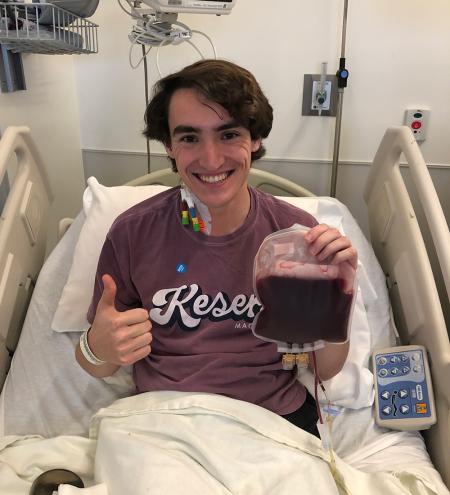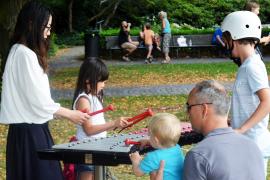College student and camp counselor Sean Clair wasn’t sure what it meant when he was asked to register to be a lifesaving stem cell donor for patients with blood cancer. Still, as an idealistic leader eager to make a positive impact in the world, he took a couple of minutes to get swabbed. A few years later, he gave someone a second chance at life.
Every 27 seconds, someone somewhere in the world is diagnosed with blood cancer adding up to over 1.2 million people diagnosed every year. For many of these of patients, a stem cell transplant is their last chance to beat blood cancer. And since only 30 percent of patients find a matching donor within their family, the majority of patients in need of a stem cell donation end up searching for an unrelated donor match.
The stem cell transplant requires a donor who is a perfect genetic match to the patient; essentially like looking for a needle in a haystack. Every time someone like Sean decides to register as a potential donor though, it is like adding another needle to the haystack. Anyone between the ages of 18 and 55 and in good general health can register as a potential stem cell donor by completing a registration form and cheek swab test.
The best donors are young, healthy, and, like Sean, eager to make an impact in the world and on others. They are leaders and role models and, not surprisingly, sometimes even camp counselors! Six years after registering, Sean received a call from the stem cell donor center DKMS saying that he was a match for a man with leukemia. Reflecting on what happened next, he shared:
“In many ways, the process felt similar to preparing for camp, in particular my first summer! I was learning and getting training, but I still didn’t know exactly what to expect once everything really started. I felt nervous butterflies, hoping that I would be asked to serve and be able to be part of this program, but at the same time, everything felt so abstract. People told me that what I was doing could save a life and that I was putting the well-being of others before myself, just like how a trainee counselor is taught to prioritize the camper experience and center their needs. Still, in the same way camp and all our counselor training only really makes sense once the kids arrive, the donation experience felt incomplete and opaque until I was really in the thick of it.”
Throughout the process, Sean learned what to expect and about the two methods of donation. The most common method of donation is called peripheral blood stem cell collection (PBSC), which is used in around 90% of cases. Here, stem cells are removed from the blood by a special procedure called apheresis. Blood is drawn from one arm and passed through the apheresis machine that filters out the stem cells and returns the blood back into your body through the other arm. To increase the number of stem cells in the blood at the time of donation, donors will receive a four-day course of a synthetic protein called filgrastim. Filgrastim signals the bone marrow to release increased amounts of stem cells into the bloodstream.
Bone marrow donation is used in about 10% of donations. It is an outpatient surgical procedure performed under general anesthesia. Doctors use a special syringe to collect bone marrow, which stores the blood stem cells, from the back of the pelvic bone. After the bone marrow has been removed, the donor may feel sore for a couple days like if they slipped on ice and fell on their tailbone. Bone marrow donation is more commonly requested by patients’ medical teams to treat pediatric cancers and certain forms of anemia.
Sean reflected on his experience as a donor, saying:

“It was amazing to see everything come together and the feelings of relief, gratitude, and hope melded together into something like euphoria. I’m still amazed that spending just a few hours connected to a machine could give someone a second chance at life. Within days, I was back to normal and hoping my cells were doing their job for the recipient, wherever and whoever they are. It felt surreal to have done this lengthy, semi-complicated, incredible thing, and at the same time already feel it beginning to recede into the past. This surreal and unexpected experience certainly ranks among the most meaningful days of my life, and yet in the immediate aftermath I found myself with little time to truly dwell on it…after all, the first day of camp was just two weeks away.”
Learn more about how to become a potential lifesaver or hold a donor drive at your camp this summer.
This blog was sponsored by DKMS.
Lauren Stock is a donor recruitment coordinator at DKMS, the stem cell donor center, where she works to find lifesaving donors for blood cancer patients in need across the world. She is also a lifelong camp kid, having spent more than a decade as a camper and counselor, knowing first-hand the power that camps have to change lives.
Periodically, the American Camp Association (ACA) makes timely and relevant information about products and services available to its members so they can make informed decisions for their camps. However, the ACA does not endorse products, services, or companies.
The views and opinions expressed by contributors are their own and do not necessarily reflect the views of the American Camp Association or ACA employees.




